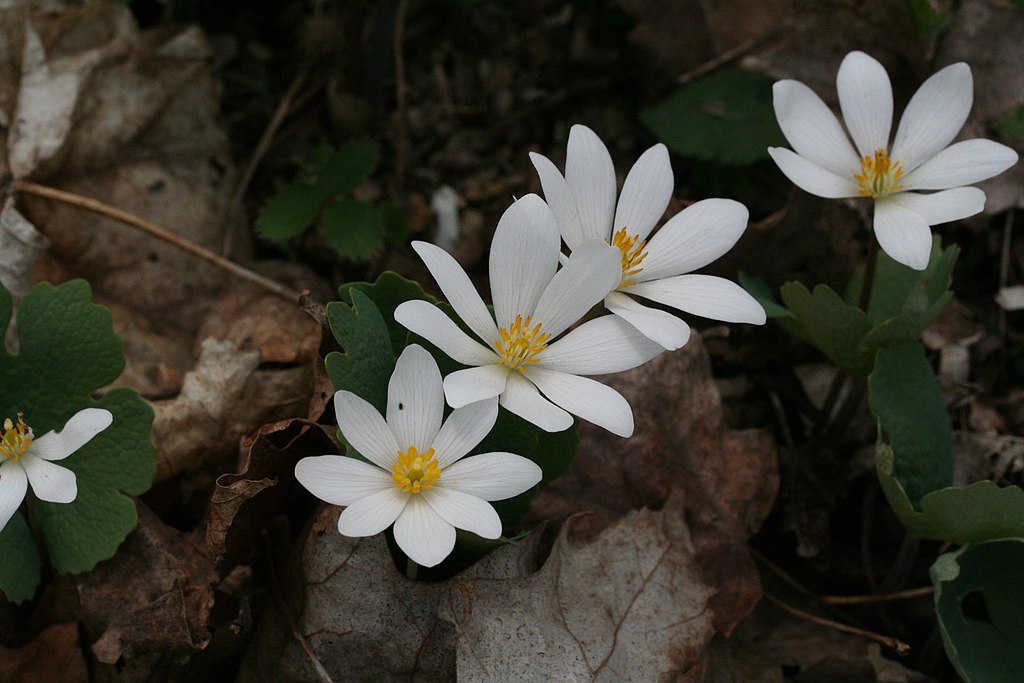It’s the spooky season again! This year, I’ve got a round up of horror-inducing plants from Atlantic Canada. Of course, whether they’re actually spooky is up for debate, but their names, folklore, and traits make them suitable for a “spooky plant” post. I’ll let you be the judge!
Ghost Pipe (Monotropa uniflora)

Ghost pipe (Monotropa uniflora) has a fitting name. Its pale, almost translucent white colour gives the plant a ghostly appearance. It only blooms for a week before withering and turning black, earning it the nickname “corpse plant.”1
Unlike most plants, ghost pipe doesn’t rely on photosynthesis for survival. Instead, it has a parasitic relationship with fungi, which allows it to thrive in dark, damp forests where light barely penetrates the canopy.
Plants that depend on fungi for nutrients are called mycoheterotrophs. Having lost all their chlorophyll, they rely on the mycelium of mycorrhizal fungi to supplement or replace photosynthesis as their source of carbon and energy.2
Blood Root (Sanguinaria canadensis)

Bloodroot (Sanguinaria canadensis) blooms in early spring, producing delicate white flowers that appear harmless. But below ground, its roots tell a darker story—when cut, they ooze a blood-red, toxic sap.
The roots contain powerful alkaloids, especially sanguinarine, which can be highly toxic—and even lethal—in large doses. Sanguinarine causes DNA damage and cell death.3 Applied to the skin, it destroys tissues. Despite this, many promote it as a “natural” remedy for issues ranging from skin blemishes to cancer, leading to disastrous consequences.3
Purple Pitcher Plant (Sarracenia purpurea)

Purple pitcher plant (Sarracenia purpurea) is my favourite bog dwelling carnivorous plant. Its purple-tinted pitchers open like wide mouths waiting to devour prey.
The plant lures insects into its tubular leaves with sweet nectar. Inside, the leaf surface is slick and lined with downward-pointing hairs, making it difficult for insects to escape. Those who become trapped fall into a pool of rainwater and digestive enzymes, where they are slowly digested—a truly dreadful way to die!
Witch hazel (Hamamelis virginiana)

Witch hazel (Hamamelis virginiana) blooms in late autumn, when most other plants have long gone dormant. Its spindly yellow flowers look like tiny wisps or spider legs against the backdrop of bare branches.
In folklore, a branch of witch hazel was used as a divining rod for finding underground water, a practice known as dowsing.4 The name “witch hazel” comes from the Old English word “wych,” meaning “pliant” or “bendable,” as the rod is said to bend downward when water is detected.4
Today, witch hazel is widely used for its astringent properties in natural skincare. Many believe it helps tighten skin, reduce acne, and relieve sunburn symptoms.
Doll’s eyes (Actaea pachypoda)

Doll’s eyes (Actaea pachypoda) is one of those plants that seems perfectly designed for Halloween. Dark black spots punctuate its white berries, making them resemble tiny eyeballs on red stems.
The toxicity of doll’s eyes enhances its creepy reputation. Its alternate common name, white baneberry, stems from the Old English words ‘bana’ or ‘bona’, which translates to ‘slayer’ or ‘murderer.’”5 The entire plant, particularly the berries, can be lethal if ingested by humans leading to vomiting, delirium, and convulsions.5 Birds, however, are immune to the toxins, making them the primary dispersers of its seeds.
Foxglove (Digitalis purpurea)

Foxglove (Digitalis purpurea) is a striking plant that, while not native to Atlantic Canada, is popular in gardens throughout the region. It has tall spikes of tubular flowers, usually purple but sometimes white or pink. Folklore has long associated foxglove with magic and mischief. Some say the flower’s shape lets foxes wear them as gloves to sneak silently through the forest and attack rural villagers.6
Herbalists have recognized foxglove’s toxicity for centuries.6 Other names, like “witches’ thimbles” and “dead man’s bells,” hint at its deadly potency.6 The plant contains compounds called digitalis, which are powerful heart stimulants, used in modern medicine in controlled doses. However, ingesting even a small amount of foxglove can lead to nausea, hallucinations, heart failure, and even death.6
Agatha Christie, renowned mystery author, used foxglove poison as a plot device in several of her novels.
Yew Tree (Taxus canadensis)

Yew trees (Taxus spp.) live long lives and are highly toxic. Canada yew (Taxus canadensis) can live up to 400 years, while English yew (Taxus baccata) has survived for thousands. This remarkable longevity, coupled with its potent toxins, has linked the yew to themes of life and death for centuries.7
Almost every part of the tree contains deadly toxins, particularly its leaves and seeds, which can cause heart failure if ingested. Robert Turner, a 17th-century translator of mystical and medical texts, noted yews growing abundantly in English cemeteries and believed they derived their poison from “suck[ing] nourishment” from the dead, whose flesh he called “the rankest poison that could be.’”7
Happy Halloween!
What do you think? Do these plants give you the creeps? If you have a “spooky plant” to add to the list, feel free to share it in the comments! Have a safe and happy Halloween!
Other Posts You May Enjoy
Witches’ Butter to Dead Man’s Fingers: A Spooky Fungi Guide
Winter Tree Survival: The Resilience of Eastern Canada’s Forests
Wabanaki-Acadian Forest: History, Species, and Biodiversity
Tree Lungwort: Lobaria Pulmonaria
Sources
1 Clary Greacen Montagne. 2020. “Into the Haunted Forest: Ghost Pipe.” Environmental Protection Information Center.
2 Sarah Watkinson. 2016. “Mycoheterotrophy” in The Fungi (Third Edition).
3 Justin Brower. “Bloodroot: The Harbinger of Spring That Will Melt Your Face Off.” Nature’s Poisons.
4 John-Manuel Andriote. 2012. “The Mysterious Past and Present of Witch Hazel.” The Atlantic.
5 Sonya Gugliara. 2024. “Urgent Warning Over ‘Nightmarish’ Poisonous Plant with Deadly ‘Eyeballs’ Spreading Across the US.” Daily Mail.
6 Joyce H. Newman. 2018. “The Truth About Foxgloves.” New York Botanical Garden.
7 Joel Springsteen. 2012. “Native Plant of the Month: Canada Yew.” Urban Ecology Center.